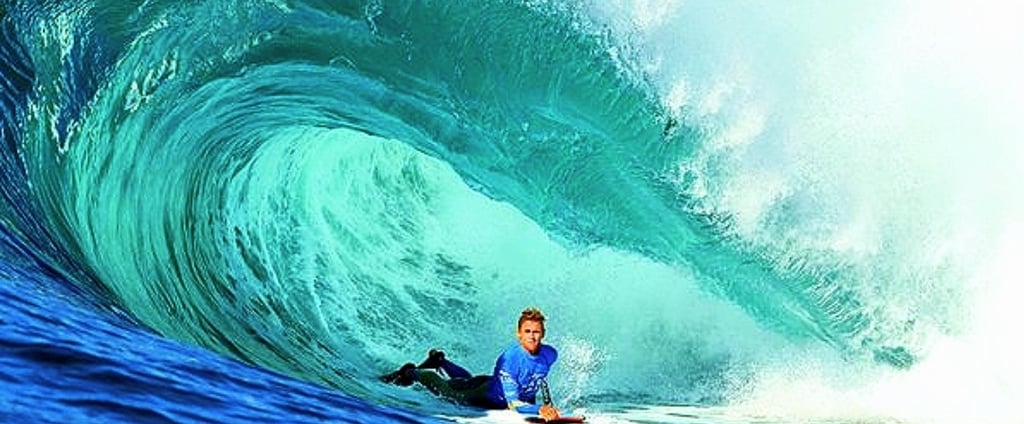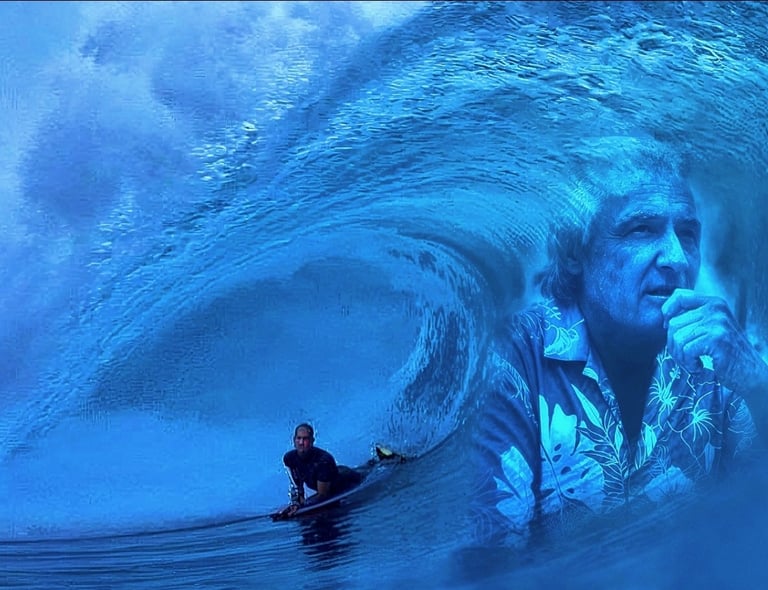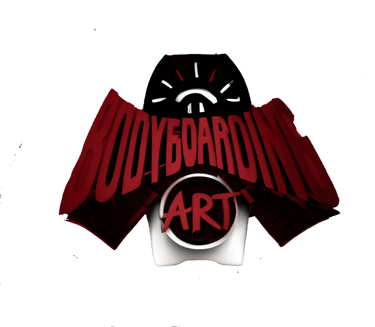Bodyboarding's Return: Tom Morey's Legacy Powers the Sport Ahead
Bodyboarding is making a powerful comeback in 2024 and 2025, driven by the enduring legacy of inventor Tom Morey. This expert-backed feature explores how Morey’s innovations, values, and impact on surf culture continue to shape a new generation of riders. From grassroots communities to global competitions, discover how his influence is powering bodyboarding’s revival and inspiring deeper respect for the sport’s roots and future.
Bodyboaringart.com inspired by the Legacy Of Tom Morey
4/15/202513 min read
Bodyboarding's Return: Tom Morey's Heritage Powers the Sport's Ahead Path
Tom Morey kickstarted the bodyboarding wave, and today his legacy pushes the sport into tomorrow. His 1971 invention, the "Boogie Board," made the ocean accessible to many. Bodyboarding, once sidelined, now takes center stage again thanks to him. For those wondering "what is bodyboarding?" or "what is a boogie board?", it's a form of wave riding that has evolved into a thrilling water sport.
As a sonic engineer, Morey used his knowledge to create the "Boogie Board" with groundbreaking tech that made it super simple to catch waves for anyone. This revolution in water sports wasn't just for the pros; it let beginners ride waves without needing a lot of skill. The question of "how to boogie board" became much easier to answer with Morey's invention.
Events like the annual Mike Stewart Pipeline Invitational honor Morey's gift to wave riding. Competitors here showcase their skills on the 'Boogie Board,' keeping Tom's spirit alive. At these gatherings, everyone gets to celebrate bodyboarding, from total newbies to the big league riders. The debate of boogie board vs bodyboard or bodyboarding vs boogie boarding is often discussed, but in essence, they refer to the same exciting water sport.
The community defends bodyboarding, eager to keep it thriving. With new materials and tech, the "Boogie Board" keeps improving. These advancements fuel a continued rise in the sport's popularity, drawing in folks of all ages. Professional bodyboarders and professional boogie boarders alike continue to push the limits of what's possible on a foam board.
Digital platforms and networks have made wave-riding enthusiasts more connected than before. They swap tricks, share stoke, and hype up every shred of bodyboarding news. This camaraderie forms a strong bond among fans, making it more than a sport—it's a family affair.
Each new 'Boogie Board' wave rider is proof of Tom Morey's lasting influence on surfing and bodyboard surfing. His simple yet brilliant vision has had a huge influence on making the waters a place where anyone can find joy and excitement. His contribution remains an encouraging factor for all who step on a board and embrace the sea's rhythm.
Back in the summer of '71 on Hawaii's Big Island, Tom Morey surfed a wave in a way he'd never done before. Standing on his made foam plank, which sported a smooth round nose and a square end, he felt he was witnessing the start of a huge shake-up. "I could sense the wave's subtle shifts through the plank," he'd remember. "My thoughts were like 'hey, this thing swerves, it's tough, won't cost a fortune, it's super light, and nobody's gonna get hurt. Man, this could take off.'" Little did Tom guess that his cool invention would ignite the beginning of boogie boards, sparking a major transformation in sea sports and fun in the water for years on end.
More than fifty years on, that "big thing" has grown into a worldwide sensation with an incredible revival. This comeback respects Morey's first idea: "The ocean gives us dreams; we protect it in return." The revival includes better ways to bodyboard and use of materials that don't harm the environment. This shows how the sport has changed from just riding waves with a boogie board to a more complex way of tackling the surf, including big wave riding and tube riding.
The Creator Who Clothed Aspirations in Neoprene
Tom Morey, who came into the world in Detroit during 1935, did a whole lot more than just whip up inventions. This guy was a true visionary who brought wave riding to the masses. Post his graduation from the University of Southern California where he snagged a math degree, Morey applied his wizardry in engineering to spark a revolution in surf culture. He kicked off with crafting cutting-edge surfboards and then went on to concoct the legendary Morey boogie board, proving just how much he shook up the surfing world.
In July 1971, he crafted what folks came to call the Morey Boogie. It's this cool, bendy board that let a whole bunch of people hit the waves, peeps who wouldn't have tried surfing at all. Later, people just started calling it a boogie board. That kicked off some chatter on whether to say bodyboarding or boogie boarding, but hey, nowadays most people just swap those words like they're the same thing.
Morey didn't think of his invention as for kicks—it meant way more, hitting him deep in the heart and soul. Being a Baháʼí follower since 1970, he gave credit to a special prayer for the idea behind the bodyboard. The prayer talked about giving him thoughts to turn the world into a flower-filled spot. That soulful bond with his creation is a reason it's known as a boogie board—Morey, who also jammed out as a jazz artist, compared catching waves to the smooth, make-it-up-as-you-go vibe of boogie-woogie tunes.
Morey never dreamt the garden would shoot up so big, but bodyboarding went from simple starts to a sport chasing the most significant waves out there. It puts on a show of amazing wave riding and stretches what we can do with wave physics. Today, professional bodyboarders tackle big waves that rival those in traditional surfing.
Rethinking Board Tech: Surf Science Rocks
Nowadays when you peek into the bodyboard tech zone, you spot mad science stuff, and three dudes always at the top are Mike Stewart, Jeff Hubbard, and Guilherme Tâmega. Each guy threw in their smarts to crank up how we see modern boards, making them tough enough for wild waves and lifting bodyboarding moves up a level. This innovation has helped bridge the gap between boogie board surfing and traditional surfing.
Mike Stewart: Surfboard Geometry Wizard
Mike Stewart, with nine world titles, tackles bodyboard design using science-like accuracy. His company Science Bodyboards offers designs born from "Real Time Innovation" – his term for creating board shapes after intense trials and evaluating how they do.
Stewart points out, "Today's boards have changing flex cores and grooves for keeping steady on monstrous waves." His brainchildren include the Science Launch lineup. This series boasts the Velocity Quad Vent system – a set of channels along the borders ending in four vents pushing speed while gripping the wave's surface.
Stewart's boards mix in earth-friendly EPS/recycled bases with carbon stringers giving a burst of energy in the clutch moments. This materials mash-up has caused a revolution in bodyboarding skill levels when bending your board to your will is crucial.
The brand's marketing team states that after loads of trial and error with heaps of shapes and materials, they've now got the bodyboard-building game down to a science. They pinpoint that their careful systematic way of making has brought to life boards that handle crazy waves nobody thought you could tackle with a bodyboard or the old-school boogie board.
Jeff Hubbard: Up in the Air
Jeff Hubbard, going by cool nicknames like the "Flying Squirrel" and "Human Missile," has caused a revolution in bodyboarding from the way he takes to the sky. His wicked moves, talking about the Hubb invert to air reverse, air Hubb, rewind, and 720 spin, have shaken things up in the bodyboarding world. These aerial maneuvers have become a staple in professional bodyboard competitions.
"Modern board construction using lightweight PE/Mesh combos, shoots tricks up to new heights," explains Hubbard about the tech in play. He's leading the way at his company, Hubboards. They put out stuff like the Quad Core and the Sci-Five Channel System, essential for crazy air tricks.
The tails on Hubboards have this special shape and grooves that make you shoot out of the water for big moves. "Rev up the speed, soar higher with our Hubb Edition featuring the Quad Core & Scifive Channel System," brags the firm. They're all about making planks that push you to nail those high-flying stunts.
Hubbard's got a big effect on how bodyboards get made. He reckons going airborne and throwing down massive tricks is a blast, more so than just cruising in tubes. This vibe's got the makers figuring out how to craft boards that are snappy and feather-light but still tough enough to hold up when you're busting out wild air moves. This shift is making today's bodyboards stand out heaps from those old-school boogie boards.
Guilherme Tâmega: Riding Giants Like a Boss
Guilherme Tâmega, who's snagged six world titles, knows a thing or two about shaping boards for mega waves. Having tackled ginormous swells, he says, "DK-specific boards now take on 20ft+ monsters at places like Nazaré." He's talking about the kit you need for nailing drop knee moves when the sea's going mental. The drop knee technique is a signature move in bodyboarding that sets it apart from traditional surfing.
GT Bodyboards, Tâmega's brand, boast tough slick undersides designed to take on the huge hit from gnarly slab waves. His Mega-T design, the board about which they say it "changed bodyboarding and Guilherme Tamega's life forever," got made again to honor the Brazilian's initial world championship victory at Pipeline scored back in '94.
The build features fancy parts such as "Freedom 6 PP or D12 PP Core, NXL Deck, Surlyn Bottom, IXL Pinline & NXL Rail, Standard Channels, and Carbon Fiber Stringer," all created to endure the harsh conditions of powerful waves. This focus on strength gives surfers the courage to take on waves that might wreck other gear, demonstrating a leap from basic boogie boarding to advanced wave mastery.
Contests: From Shoreline Challenges to Big Risks
Bodyboarding contests have really shaped up into quite the tale when you look at how things have changed. It kicked off with simple matchups on regular old beach breaks but now, oh man, it's a whole big deal with a worldwide tour that throws down some insane waves. This rocketed bodyboarding right up there in the big leagues of wave riding stunts and oceanic showdowns.
The Heavy Water Shift
So, the APB Tour, yeah that's the Association of Professional Bodyboarders, took a mega turn with where they decide to throw these showdowns. We're talking next-level spots that show what bodyboarding's got under the hood. Think of gnarly waves at places like Pipeline in Hawaii, Teahupo'o in Tahiti, and let's not even start on the Nazaré in Portugal. These big wave competitions have become a highlight of the APB World Tour.
APB Tour boss Alex Leon spills the beans on the new game plan. He says, "Praia do Norte [Nazaré] is one of the top beach breaks around that can handle super gnarly waves, making it a dream spot for top-tier bodyboarding."
Pro bodyboarder Amaury Lavernhe talks about the wild ride of competing at these places: "The conditions are bonkers. The heats are super tough, I catch as many waves as I can." This push for tough waves has pumped up the sport's rep and pulled in fans who dig the talent needed to tackle these gnarly waves.
Safety Innovations Tag Along with Performance
Safety tech has had to step up cause we're riding crazier waves these days. We're talking jet skis on standby, fancy impact gear, and solid emergency plans that the old-school riders didn't have.
The APB pulled a bold move with Teahupo'o in 2016, throwing in safety stuff like never before. Amaury Lavernhe, who knows a thing or two about winning, was like, "We got a jetski ready for each rider just in case things get gnarly."
So yeah, we're pushing limits but not forgetting to keep our athletes out of harm's way. It's why the sport's getting into super gnarly waves that used to be a no-go for competing. It shows how bodyboarding can handle badass conditions, which kind of sets it apart from just chillin' with a boogie board on the waves.
AI & Eco-Future: Catching the Digital and Environment-Friendly Tide
A comeback in bodyboarding isn't just about better performances in rough waters. Two big changes—one in technology and one in green practices are changing the game for riders. They're using AI to predict waves for bodyboarding and making boards that don't harm the environment.
AI and Hunting Waves: Making Decisions With Data
Artificial intelligence is now a big part of predicting surf conditions. It's changing how bodyboarders pick times to hit the waves and where they go. Services like Surfline are using advanced AI systems to make way better guesses on how the swells will be.
"Surfline slashed its error rate by 50%, thanks to heaps more data and better machine learning," says Experience Magazine. They've got over 1,000 cams all over the globe and loads of wave info from years gone by. This stuff lets them call the surf conditions super, like a fortnight out.
Wave riders on bodyboards get to hunt for the sickest waves more with this tech jump. They're not guzzling gas going places with maybe-no-good swells. Instead, they decide with the right info when and where to hit the waves, shrinking their eco footprint while doing it.
Ben Freeston, the big cheese for new ideas at Surfline, gets into how AI is spicing up finding great waves. He says, "We can tell you, 'These waves are just like the ones you loved.'" This custom touch helps bodyboarders get the most out of the ocean without wasting trips and keeps it cool with the eco-friendly surfing vibe.
Eco-stuff for the Waves: Surfing the Eco Trend
Big changes are coming for bodyboard fiends with the industry choosing to be nicer to the planet. Tom Morey, who was all about that nature love in his work, would have been stoked. We're seeing a huge change in the stuff we take to the waves and how we come up with new tricks for water play.
Nowadays, the folks who make our gear are all about using stuff that doesn't hurt the Earth and ways to make things that are better for our planet.
Recycled PET Skins: Bodyboards now have their exteriors made from used plastic bottles. Atunas, a company in Taiwan, makes these boards with a combo of "recycled plastic pellets from PET bottles and mixed with residual materials from the production process." They're crafting sturdy, eco-conscious next-gen bodyboards by reusing rubbish.
Plant-Based Resins: Bodyboard creators are getting inspiration from surfboard trends and starting to use bio-resins made from plants, not oil. Cleanline, the surf magazine, mentions, "Various companies are leading the charge with products such as leashes made from recycled plastic bottles and plant-based rubber, traction pads crafted from algae, and surf fins utilizing materials like recycled PET and upcycled fishing nets."
Formed Construction: Innovative production methods are making old lamination techniques obsolete. Atunas is at the forefront, with "forming technology, which does away with the surface lamination process and increases the material's toughness by altering molecules during the thermoplastic pressurization process, lessening the chances of surface cracking or coming apart." These eco-friendly programs capture the essence of Morey's green principles. Folks in the know said, "He'd make sure we came up with ideas that kept the planet in our thoughts." So now, we've got this new crop of bodyboards that rip but don't mess up the environment as much. Just take a gander at the Mach 12 Eco Tech for a prime example.
Tom Morey's Living Legacy
Even though Tom Morey checked out in October 2021 when he was 86, the genius vibe he brought to the table still rocks every part of bodyboarding today. He left a mark in three major spots that keep nudging the sport into the future. It's like Tom Morey's smarts with bodyboard building still hang around:
The Innovation Mindset
Morey sparked innovation waves with his early surfboard changes, including the debut concave nose pocket in 1954 and the "Wing Tip" a year later. His classic Morey boogie board kicked off a trend of never-ending upgrades that sticks in bodyboarding now. Today's shapers keep this vibe alive, always testing limits by playing with fresh materials, designs, and tech.
The Ethic of Getting to Everyone
Morey changed the game when he made wave riding a thing anyone could enjoy. He priced the first Morey boogie board at $37, yeah, 'cause he was 37 at that time, so everybody, no matter their age or how good they were, could get a taste of the ocean. These days, the boogie board scene still digs that vibe of being open to all and keeps pushing just how awesome these boards can get, never forgetting that it's all about the good times and keeping it easy for everyone to join.
The Commitment to Our Planet
Morey felt this deep tie to the sea, something his Baháʼí faith played into. He set up this mindset that if the ocean makes us happy, we've got to take care of it. That kind of thinking has caught on, and now you've got these new companies popping up with eco-friendly boards, recycling old gear, and making sure our beaches stay clean.
He kicked off a trend that's grown into what lots view as an "alternative surf lifestyle." It's like bodyboarding is a way to stick it to the man for Mother Earth, mixing fun and looking after the environment.
Catching the Next Big One: Bodyboarding's Eco-Friendly Tomorrow
Bodyboarding's stepping into an awesome new phase right now. A combo of better moves, cool tech, and thinking green is lighting up the sport's path ahead. People used to just see it as surfing's kid sibling, but now it's got its own rep—one that tips its hat to what Tom Morey first dreamed up, while surfing into zones he never thought up.
The booming waves of Pipeline and Nazaré's giant swells are still making waves, while tech like AI forecasting and green building techniques keeps bodyboarding fresh. This evolution honors the dude who dreamed it up. As the sport's popularity soars, it takes Tom Morey's ideas of a give-and-take between surfers and the sea to heart – everyone's stoked and looking out for the ocean.
Back in the day, Morey rocked neoprene dreams. These days, a bunch of fresh faces are doing their own thing, mixing creativity with a nod to the past. Wanna back eco-friendly bodyboarding? Grab one of our 100% organic cotton tees.
Every sale helps the ocean stay rad. Check out the Legacy Collection. #RideLikeMorey
The piece here is all about the current boom in bodyboarding, giving props to both the cool new tech pushing the sport's limits and the rising dedication to taking care of our planet, something that would get a thumbs up from Tom Morey. The way bodyboarding is changing shows that the super cool part of Morey's idea wasn't just about making a new kind of surfboard, but more about how that board linked up surfers and the sea in a two-way street of giving props and looking after one another, which is what's gonna steer the sport going forward.
From the International Morey Boogie Bodyboard Pro Championships to the modern APB World Tour, bodyboarding competitions have evolved significantly. Professional bodyboarders like Ryan Hardy, Pierre-Louis Costes, and Ayaka Suzuki continue to push the boundaries of what's possible in the sport. Events like the Shark Island Challenge showcase the extreme side of bodyboarding, often featuring waves that measure high on the Hawaiian scale.
Whether you're into boogie board surfing or prefer the more competitive world of professional bodyboarding, the sport offers something for everyone. From learning how to boogie board on your first foam board to mastering advanced techniques like the drop knee or aerial maneuvers, bodyboarding continues to evolve and excite water sports enthusiasts around the world.






